Sarrio: Pyrenean suede
It is generally admitted that rupicaprinios were ancestors of goats, and that goats and sheep show the premiere development of some precarious form of the Rupicaprini group. Evolutionary separation was extended along the Miocene for 7 to 26 million years.

The Rumiaprinians, although seemingly founded in Asia, had a very wide distribution in Eurasia, and perhaps also in Africa. At present, the distribution of Asian representatives does not extend beyond Japan, but some of the ancestors of these forms had to migrate to North America to create the goat of Rocky. Except for the representatives of Europe and America, little is known of the species of this tribe.
The evolutionary history of the genus Rupicapra is immersed in a dark night, with the oldest fossils found in the late European Pleistocene, only a million years ago. The chamois, beginning with the Caucasus, have spread throughout eastern Turkey and Europe, spreading across the Balkans, Carpathians, Alps, Pyrenees and the Cantabrian Mountains. In the Caucasus can be found between 150 and 4,000 m, both in dry areas and in more humid areas strongly snowy. Several populations live in forests from 700 to 2,000 m. Others travel in summer to subalpine and alpine areas between 1,700 m and 2,500 m.
In Europe they also inhabit oak and alpine grasslands of the Alpe and Tatra mountains, although they often retreat to the forest in winter. Recently incorporated into New Zealand, they have occupied cliff-cut land between 800 and 2,000 m, avoiding forests as much as possible. In short, the only characteristics that define this species are mountaineering and the hobby of rock.
Pyrenean suede
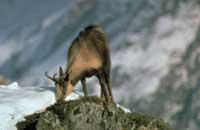
Until recently, the Pyrenean chamois, popularly known in Basque, was grouped together with the rest of the chamois in a single species ( R. rupicapra), from genetic analyses of serum proteins, until it was postulated that it could be a different species ( R. pyrenaica). The lower latitude chamois, that is, the populations of the Pyrenees ( R. p. pyrenaica), the Cantabrian Cordillera ( R. p. parva) and Abruzzo ( R. p. ornata), and the so-called dark chamois ( R. rupicapra), were given in different radiations from the Middle East, and in the Miwjazz first. However, in recent years, the presence of chamois in mammals is one of the highest genetic variations, which has somehow dampened this differentiation between species.
The Sarrios are confined to the Pyrenean chain, where they depend on different management models: Protection in the National Parks and Nature Reserves is integral, and both in the National Hunting Reserves of Aragon and in the National Hunting Reserves of Catalonia, the amount previously fixed is hunted, accompanied by tremor. In protected areas, the sarrio works as a tourist attraction and in hunting reserves must be paid for hunting the piece. It is therefore a natural resource that generates economic benefit.
The total length of the body, from the narrowing of the end to the implantation of the tail, ranges between 105 cm and 110 cm and has a height of 69 cm until the coronation. Ear and tail up to 12 cm.

To facilitate mountain life, it has several characteristics: interdigital membranes, favoring the march through the snow; cautious and very mobile consistencies at the bottom of the foams, which also facilitate the displacement through cliffs of large rock and slope.
Also noteworthy is the size of the heart, which has a weight of 350 g on the corporate weight of 30-40 kg (remember that the human has 280 g next to the 70-80 kg of the body). Muscle fibers are also one of the densest known. The coat supports two dumps a year, with the start before the change in the specimens in better physical conditions.
The branches of the females and the males are similar and do not lose or renew their horns every year: the branches once developed are forever. Unlike the branches of deer and akers, the most frequent are thin and short, dark and straight, becoming the final end in the form of a hook. Sexual differentiation, therefore, is helped by other anatomical and play characteristics, such as the presence of the penian brush of the males, the thickest branches of the males, the shape of the body or the posture for urination (breading). The branches grow constantly and the branches of young people between one and two years do not exceed the ear. Due to the differential growth that occurs at different times of the year, rings are created on the branches that offer the simplest system to estimate the age of the animal.
These animals are mainly grasslands, but by increasing the herbaceous capacity, in winter they are mostly allied in trees and shrubs. From spring to autumn you can see most of the deserts, so called in the Pyrenees, the summer pastures of the cattle, from the forest that serves as a refuge in winter. In May it is given birth with the breeding and the heat is prolonged during the months of November and December. Although they can be seen in large groups, the only strong link between individuals is between the mother and the child of the year, as in most other ungulates. The cause of aggregation is variable: on the one hand, they can be grouped into localized areas where the herbaceous supply is abundant and, on the other, they can form large groups to ensure the safety and care of newborns.
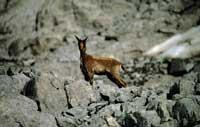
In the latter there can be real lithologies in which most of the offspring are in charge of a few females. In any case, the males are excluded from these groups and although in general they are solitary, we will see them in heat together with the females. At that time, the male defends the group of females he is called. In fact, it protects those who will transfer their genetic heritage to future generations.
Females can proliferate from the second year of life. In any case, the proportion of bee females of different age classes depends on the density. In most cases, as the density increases, the proportion of females who can carry out the breeding decreases. In addition, in the case of deer, for example, calving and puppy growth are a huge expense for the mother. In general, the unborn female arrives in better physical conditions, which makes the following year more likely to have a baby. The effects of this can be increased or softened with population density.
Today, large Pyrenean natural predators are kept missing (wolf), in extinction (bear) or in minimal quantities (lynx, black eagle). Thus, pathogens have become the ruler of the number of Pyrenean herbivores. Some diseases that have affected populations of chamois in recent years are pleuroneumonia and infectious keratoconjunctivitis, with significant reductions in population size in some places.
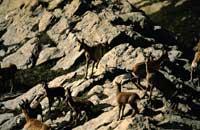
Then, more is known about the kinetics of parasitic infestation or about the convenience of possible treatments. Also, due to the specificity of parasites that can be found in the rebecos, contamination by domestic ungulates is quite limited. On the contrary, it seems that epizootia from domestics would have a more negative effect on chamois. In general, knowledge of health status in the management and management of wild animal populations has become a new and important tool.
Let us also say that, to a large extent, the number of current occasions is artificially high. And it is that for thousands of years man has lowered the altitudinal limit of the forest, increasing in return the supraforestal pastures. In addition, in recent decades the livestock pressure has been significantly reduced in the Pyrenees, so competition for pastures they could have with livestock has been considerably reduced.
And in Euskal Herria?
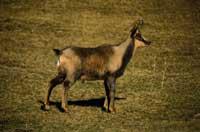
As for ours, the Sarrios are concentrated in the highest vertices of eastern Navarre and in the Pyrenean slope of Baja Navarra and Zuberoa. However, in the ancient documents that mention the hunts of Sancho the Wise, it can be read that in the mountains of Roncesvalles in the year 1165 acquired 12 rebecos. The aforementioned testimony has become a clear exponent of the historical regression of the species in the Basque Country. Similarly, through the review of the bibliography of recent years, contradictory and obscure references of the Navarrese Sarries can be found. With the aim of knowing the current distribution of the species in Navarra and the population, the Government of Navarra hired a study in 1992.
In this sense, depending on the results obtained, you can find entries in a stable way in two points: In the Larra/Belagoa Nature Reserve (LBEN) and in Mount Ezkaurre. However, the situation is completely different in each case.
In Larra/Belagoa about 110 animals have been censored, with a density of 5.7 ind./km 2, and it seems that the trend of recent years is growing. Unlike the rest of the Pyrenean chamois, those of Larrea in summer do not climb up the edges occupied by cattle, but can be seen throughout the year in the forest. In addition, perhaps due to low density, males and females do not separate completely, being able to see mixed groups throughout the year.
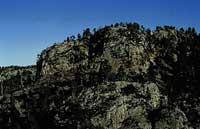
In Ezkaurre there are between 10 and 20 animals and in recent years there has been no increase in the size of the group. This area, in addition to not being protected, supports in summer a huge livestock pressure.
Next to these two areas is the National Hunting Reserve of Los Valles de Aragón, with a density of 2.1 individuals/km 2.
In Navarra the species does not have special protection figures, but it cannot be hunted according to the Foral Order of Beda that is renewed annually.
In the northern Pyrenean slope there is reason to think that the regression has been evident, since until 1991 30 permits were extended to hunt the sarrio, since then two permits are distributed between the two peoples of the area. Currently, the Goards of the Office National de la Chase indicate 8 units. Also, in the chain that extends from the CNC to the west, today they are not observed frequent, although a few years ago it was quite common.
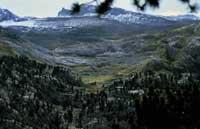
The Sarrios of Navarre are the western boundary of the subspecies. This gives them a special value, since they can be considered “thermometers” of the rest of the populations of the Pyrenean mountain range. If we consider that the limit of the distribution area is the area that allows the presence of individuals in unoptimal conditions, among which interspecific competition, irregular reproduction and extreme environmental conditions, should be placed between the CNC and Orhi. The actual distribution area is probably reduced either by cattle pressure or by poaching. That is why in this situation repopulations in those areas where there are currently no frequent but can be maintained may be considered pertinent.
The chamois of Euskal Herria, of course, do not know the administrative limits or their horseshoe areas respect the mojones. The same species is subjected to three very concentrated management systems: the destruction of the north, the hunting exploitation of Aragon and the integral protection of the south. Coordination between the three administrations involved is essential, especially to channel any initiative that aims to promote the rational use of the environment.
Sarrio Family: Subfamily |





